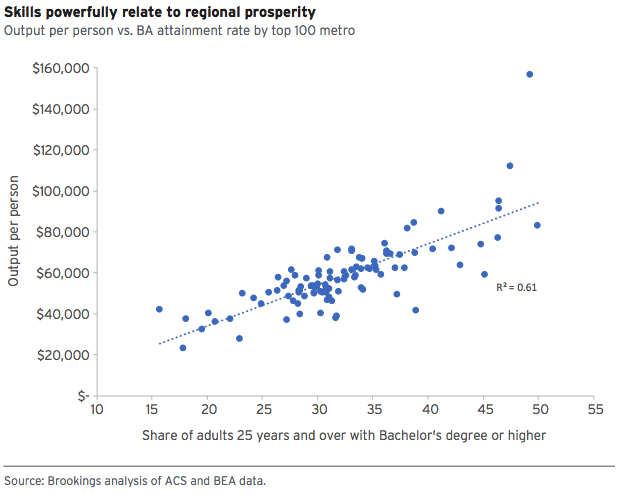What City Observatory did this week
1. Tim Bartik explains business incentives. States and cities spend about $50 billion a year on tax breaks and other incentives to try to influence business location decisions. The nation’s leading scholar on the subject, Upjohn Institute’s Tim Bartik, has a new book explaining succinctly and in non-technical terms about whether these incentives work and what can be done to make them work better. Bartik’s research shows that roughly three-quarters of time, incentives make no difference to business location choices–they’re simply wasteful. But its almost always impossible to convincingly argue that any individual deal is one of the three-quarters that are giveaways, and it’s very much in the interest of prospective recipients (and economic development agencies) to always argue that their incentives is making a difference. Ultimately, the reason incentive deals persist (and have grown to such huge proportions) is that the political calculus rewards deal-makers, who are seen as “doing something” to benefit the economy, while the costs are generally hidden and passed on to others. Because of this dynamic, we can’t expect incentives to go away, but Bartik has four concrete suggestions for policy makers looking to minimize the costs of incentives and maximize their benefits. You can buy printed copies of the book, or download a free PDF; either way, its a must read for anyone interested in economic development.
2. Portland’s regional government is push-polling a climate change denial message. Portland and Oregon have both fallen behind in their stated efforts to reduce greenhouse gas emissions, largely due to increases in driving. At the same time, the regional government is moving forward with a multi-billion dollar transportation funding measure. It commissioned some survey research, ostensibly to gauge public attitudes on the subject, but in practice, the survey is a thinly veiled effort to foist some phony choices and factually inaccurate claims on the public. The survey repeatedly claims that greenhouse gas emissions can be reduced by eliminating congestion so that cars don’t have to idle in traffic so much–a thesis that has been disproven. Actually, the opposite is the case: measures that speed traffic create induced demand, and the carbon emissions from more driving increase greenhouse gas pollution, rather than decreasing it. The purpose of the survey is plainly to develop the talking points and media campaign for selling a funding measure. It’s dishonest and reprehensible for a public body to disseminate a phony and misleading message about the causes, and solutions to the climate crisis. This is what climate change denial looks like.
3. More evidence for the importance of talent to metropolitan economic success. The Brookings Institution has a new report “Talent-Driven Economic Development: A new vision and agenda for regional and state economies.” As the title suggests, the authors build the case for focusing on building skills and talent and outline the steps cities and states can take. Their research confirms the strong relationship between the educational attainment of the population and the productivity of the local economy.
It’s clear that working to increase the talent level of the local population is key, and the report describes a series of strategies for doing so, including more formal education (helping high school students reach college, and succeed once they’re there), and also helping and encouraging employers to provide additional training to their entire workforce (and not just those with the highest levels of skill, which tends to be the pattern). The sole caveat one might add to this report is the observation that talent is mobile, and well-educated workers tend to be gravitating to great urban locations. As a result, cities should look both to investments in increasing skills and talent, and also in building the kinds of great urban neighborhoods that will attract and retain talented workers.
Must read
1. Forget new technology, fixing transportation is about making the right choices. Henry Grabar has a perceptive essay at Slate debunking the fascination with technological solutions to our transportation problems, and emphasizing that how we build cities, and how we employ well-proven technologies like bikes, buses and elevators is really where the future lies. Hyperloops and autonomous vehicles get all the attention it seems, but miss the point that building walkable, human-scaled cities and neighborhoods rather than sprawling automobile-dominated ones is needed.
The tools we need to change transportation are right there in front of us. It’s not the lack of bleeding-edge technology that has stopped us from building cities where a person can live without owning a two-ton, $25,000 vehicle . . . It’s not for want of “innovation” that we aren’t turning parking into parks, or traffic-clogged arterial roads like New York’s smoggy crosstown arteries into multimodal streets. It’s not the deferred promise of automation that stops us from charging people for the full, ice cap–melting cost of driving. The future of transportation is not about inventions. It’s about choices.
A big part of our problem is that we’re obsessed with movement, rather than with destinations. We treat transportation as an end in itself, rather than as a means of accessing people, opportunities and experiences. When we build systems to maximize speed and travel, we produce sprawling, automobile-scaled environments that are inimical to enjoying life. Just as the last great technology revolution (the automobile) only made things worse, newer iterations, like the autonomous vehicle and the hyperloop, will not overcome this essential problem. As Grabar writes:
A better world is possible, and it doesn’t start in the U.S. patent office or with what is on display at the Detroit Auto Show, the Paris Air Show, or the Consumer Electronics Show in Las Vegas. It won’t require supersonic travel tubes or cars that drive themselves. The ideas are here if we want them. We’ll have to rethink the trip, but even more than that, we’ll have to rethink the places we’re trying to connect.

2. Devin Bunten: Housing affordability and gentrification. Writing at CityLab, economist Devin Bunten sets out to untangle the links between housing affordability and gentrification. This is a thoughtful, and extremely well-written essay. It makes many important and salient points in eloquent and persuasive fashion. For example, Bunten writes:
Housing policies are designed to ensure that new neighborhood entrants are as rich or richer than those who arrived before them. The typical resident of multifamily housing in the U.S. earns half as much as the typical resident of a detached single-family home. A ban on apartments is a ban on these families. Within single-family-home neighborhoods, minimum lot sizes are wealth sieves.
While in some senses these problems are separable (affordability problems tend to be region-wide; gentrification is much more localized), it’s difficult to argue that they are un-related. Gentrification is a more severe and widespread problem in markets where housing shortages and affordability problems are most acute. In many cases, gentrification occurs when demand for high amenity housing can’t be met by building additional units in high amenity neighborhoods, chiefly because of zoning limitations and NIMBY opposition. Gentrification and housing affordability are both symptoms of our shortage of cities: the growing demand for urban living is running headlong into serious constraints on building more housing in great urban neighborhoods. Gentrification and housing affordability may not be exactly the same problem, but an essential part of any solution to both problems is allowing for more housing to be built in cities.
3. How Los Angeles is planning to make its housing problems worse. It’s well-established that Southern California’s housing affordability problems stem from the difficulty of building additional housing in the most desirable parts of the region. In theory, the state’s land use laws require the region to plan for enough space to accomodate housing demand, but there’s a hitch. The estimated regional total demand for new housing is allocated across different local jurisdictions under a process know and RHNA, the Regional Housing Needs Allocation. The allocation is prepared by the Southern California Association of Governments, a confederation of cities and local agencies. The problem is that the allocations are skewed away from high demand locations. As Leonora Camner, writes in an Op-Ed in the Los Angeles Times, the allocations bear little relation to where housing is needed.
Beverly Hills, which has nearly twice as many jobs (57,000) as people (34,400), needs only 1,373 new units of housing. Meanwhile, the desert city of Coachella, with a population of 42,400 and 8,500 jobs, will be expected to build a whopping 15,154 units.
This matters because building more housing at the urban fringe, far from job centers, makes the region even more car-dependent, and locks in long commutes and high levels of greenhouse gas emissions. It may seem like a minor technocratic detail, but tweaking these planning estimates to allow for more new housing where its most needed is essential to addressing housing affordability, transportation challenges, and climate change.



